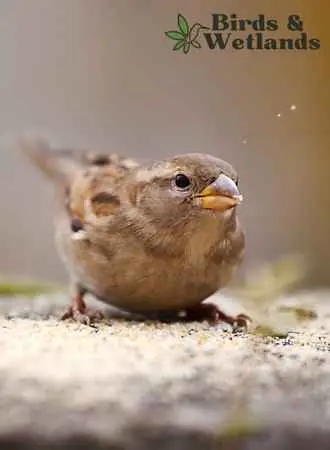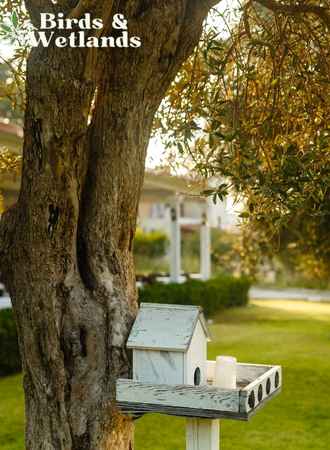Bird feeding can be a delightful experience. Not only do they add beauty to your garden, but they also help to keep the ecosystem in balance by pollinating flowers and eating insects.
Setting up a bird feeder in your garden can be an excellent way to attract various birds. However, you can’t just hang your feeders anywhere. A poorly placed bird feeder can be uninviting to birds or even pose a danger to them.
In this post, we’ll explore some of the best places to put a bird feeder in your garden to help you create a bird-friendly space that your feathered friends will love.
Key Takeaways on Where to Place Bird Feeders
- Right placement of feeders in your yard is essential for the health and safety of birds and the enjoyment of birdwatchers.
- Position your feeder at least two to three meters (six to ten feet) away from the house and try to hang it so that it is far enough away from windows to prevent collisions.
- The ideal height should be easy to access for the birds but not too low that it can be easily accessed by predatory animals.
Why does proper bird feeder placement matter?
Placing your bird feeders filled with bird food in the right places can help attract birds. But how you position your bird feeder can affect the bird species that visit, how often they come, and the overall well-being of the local bird population.
Here are the reasons why where you place your bird feeders matter:

Safety
One of the primary reasons for proper bird feeder placement is safety. You want to avoid positioning your feeder in a location where it can become a hazard for birds.
For example, placing it too close to windows can lead to collisions, which can injure or kill the birds. Similarly, placing a feeder in a location easily accessible to predators, such as cats or hawks, can put the birds in danger. As birds eat, they are vulnerable to predator attacks.
Additionally, use a squirrel proof bird feeder or a squirrel baffle to prevent squirrels and other threats from raiding your feeders.
Access
Another important consideration is accessibility. You want to place your bird feeder where most birds can easily access it without being hindered by obstacles or other deterrents.
For example, if you have a lot of trees or shrubs near your feeder, you may want to trim them back to make it easier for birds to reach the feeder.
Moreover, having multiple bird feeders instead of one can invite more birds to your garden.

Visibility
Visibility is another key factor to consider when placing your bird feeder. You want to choose a location that allows you to see the birds as they come and go. This can be especially important for birdwatchers who enjoy observing and identifying the different species that visit their feeders.
Hygiene
Proper bird feeder placement can also help with hygiene. If you position your feeder in a location that’s easy to access and clean, you’ll be better able to maintain it and keep it free of mold, bacteria, and other harmful substances that can affect the birds’ health.
Bird behavior
It’s important to consider the behavior of the birds themselves. Different species have different feeding habits, and the location of your feeder can affect how often they visit and what types of birds you attract.
For example, some birds prefer to feed on the ground, while others prefer to feed in trees. Understanding the feeding habits of the birds in your area can help you choose the best location for your feeder.
Placing bird feeders that mimics a bird’s natural feeding preferences can help in attracting birds.

Should bird feeders be in the sun or shade?
When deciding where to place a bird feeder, it’s important to consider the weather and climate in your area. Bird feeders can be placed in the sun or shade, depending on your specific situation.
Placing a bird feeder in the sun can be beneficial in certain conditions. Sunlight can help keep the birdseed dry and prevent mold growth. It can also help melt snow or ice that may accumulate on or around the feeder in colder climates. However, excessive sun exposure can cause the birdseed and sugar solution to spoil, especially in hot and humid weather.
On the other hand, placing a bird feeder in a shady spot can help keep the birdseed fresher and prevent spoilage in hot weather. Birds may prefer to feed in cooler, shaded areas on hot days. However, a shady location may also be more prone to mold growth and dampness, particularly if there is insufficient air circulation.
How far should a bird feeder be from the house?
n general, a distance of at least 2-3 meters (6-10 feet) from the house is recommended to prevent birdseed and droppings from accumulating on the house or attracting pests.

Is it safe to hang bird feeders near windows?
One concern is that birds may fly into windows when they are attracted to the food in the feeders. This can lead to injury or death of the birds, which is obviously not desirable.
To prevent window strikes, you can try to hang your feeders at least three feet away from any windows. This distance should be far enough away so that the birds are not likely to accidentally fly into the glass.

Can a bird feeder be too low?
A bird feeder can be too low, which can create some potential risks for the birds that visit it. For example, a bird feeder that is too low may be more accessible to predators such as cats, raccoons, or squirrels, which can pose a threat to the birds that come to feed.
Additionally, if the hummingbird feeder or suet feeder is too low, it may make it easier for birds to collide with windows, especially if the feeder is located near a window. Birds can be injured or killed from window collisions, so it’s important to take steps to minimize this risk.
On the other hand, having a feeder too high can also be problematic. If the feeder is too high, it may be difficult for smaller birds to access it, or it may sway too much in the wind, causing the birds to feel unstable and reluctant to feed.
A good rule of thumb is to hang a bird feeder at a height where it is easy to access for the birds but not so low that it is easily accessible to predators. The ideal height will depend on the type of feeder and the type of birds you are trying to attract, so you may need to experiment to find the optimal height.
More Tips on Where to Place Feeders
- Passing birds visit yards with feeders to refuel and rest before they proceed to their wintering grounds. Having suet feeders in your feeding station can help many birds.
- Tube feeders and hummingbird feeders should be placed in sheltered areas protected from winds.
- Once your start feeding birds, it won’t be long before hawks and other birds of prey start perching on nearby branches. Position feeders away from these areas to protect feeder visitors.
- Use ground feeders to feed many species of ground-dwelling birds. You can also leave loosely stacked brush piles near your feeders for these birds.
- Don’t hang feeders where cats and other ground predators can reach them.
- Once birds visit feeders in your yard, start offering a variety of bird food such as black oil sunflower seeds, suet cakes and fruit.
- Plant native plants with thick foliage around your feeding area to provide jumping off points, natural shelter and hiding places for small birds.
- Placing feeders away from tree branches, garage door, wind chimes, tree trunks and active areas of chipmunks and other predators can help make birds feel safe and give them a personal space and quiet spot.


